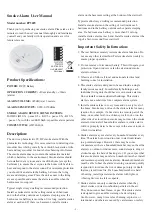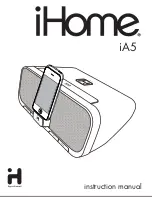
Smoke Alarm User Manual
Model number: FP500V
Thank you for purchasing our smoke alarm. Please take a few
minutes to read the user’s manual thoroughly and familiarise
yourself and your family with its operation and save it for
future reference.
Product Specifications:
POWER: DC9V Battery
OPERATION CURRENT: <10uA (standby), <30mA
(alarm)
ALARM VOLUME: >85dB(A) at 3 meters.
ALARM SENSITIVITY: 0.090-0.150dB/m.
SMOKE ALARM DEVICE SOUND PATTERN:
ISO8201 (BI 0.5s - pause 0.5s - BI 0.5s - pause 0.5s - BI 0.5s
- pause 1.5s, with the red LED flash, repeat this alarm pattern)
COMPLY WITH: AS3786:2014
Description:
The unit is a photoelectric 9V DC smoke alarm. With the
photoelectric technology. It is more sensitive to detecting slow
smoulder fires which generally have thick, black smoke, little
heat and may smoulder for hours before bursting into flames.
The smoke alarm does not contain the radioactive material
which is harmless to the environment. Smoke alarms should
be installed in every room and area of the home (except the
bathroom), to ensure the everyone in the home will be able to
hear and respond to the alarm sound. For minimum protection
you should fit an alarm in the hallway between the living
areas and sleeping areas. Place the unit as near to the living
areas as possible and ensure the alarm is audible when the
bedrooms are occupied.
Typical single storey dwelling recommended protection:
Install a smoke alarm on the ceiling inside each bedroom
and in the hallway outside each separate sleeping area. If a
bedroom area hallway is more than 9.1m long, install a smoke
alarm at each end. If there is a basement: install a smoke
alarm on the basement ceiling at the bottom of the stairwell.
Typical multi-storey dwelling recommended protection.
Install a smoke alarm on the ceiling of wall inside each
bedroom and in the hallway outside each separate sleeping
area. If a bedroom area hallway is more than 9.1m long,
install a smoke alarm at each end. Install a smoke alarm at the
top of a first–to-second floor stairwell.
Important Safety Information:
1: The test button accurately tests smoke alarm functions. Do
not use any other test method. Test smoke alarm weekly to
ensure proper operation.
2: Do not remove or disconnect battery. This will negate your
protection. Open windows or fan the air around smoke
alarm to silence it.
3: Observe and follow all local and national electrical and
building codes for installation.
4: This smoke alarm is designed to be used inside a single
family residence only. In multi-family buildings, each
individual living unit should have its own smoke alarms.
Do not install in non-residential buildings. This smoke
alarm is not a substitute for a complete alarm system.
5: Install a smoke alarm in every room and on every level of
the home. Smoke may not reach the smoke alarm for many
reasons. For example, if a fire starts in a remote part of the
home, on another level, in a chimney, wall, roof, or on the
other side of a closed door, smoke may not reach the smoke
alarm in time to alert household members. A smoke alarm
will not promptly detect a fire except in the area or room in
which it is installed.
6: Smoke alarm may not alert every household member every
time. The alarm horn is loud in order to alert individuals
to a potential danger. However, there may be some
circumstances where a household member may not hear the
alarm (i.e. outdoor or indoor noise, sound sleepers, drug or
alcohol usage, the hard of hearing, etc.). If you suspect that
this smoke alarm may not alert a household member, install
and maintain specialty smoke alarms. Household members
must be able to hear the alarm’s warning sound and quickly
respond to it to reduce the risk of damage, injury, or death
that may result from fire. If a household member is hard
of hearing, install special smoke alarms with lights or
vibrating devices to alert occupants.
7: Smoke alarms can only sound their alarms when they
detect smoke or detect combustion particles in the air.
They do not sense heat, flame, or gas. This smoke alarm
is designed to give audible warning of a developing
fire. However, many fires are fast-burning, explosive, or
intentional, and others are caused by carelessness or safety
AS 3786-2014
Lic.SMK40627
SAI Global
- 1 -
























